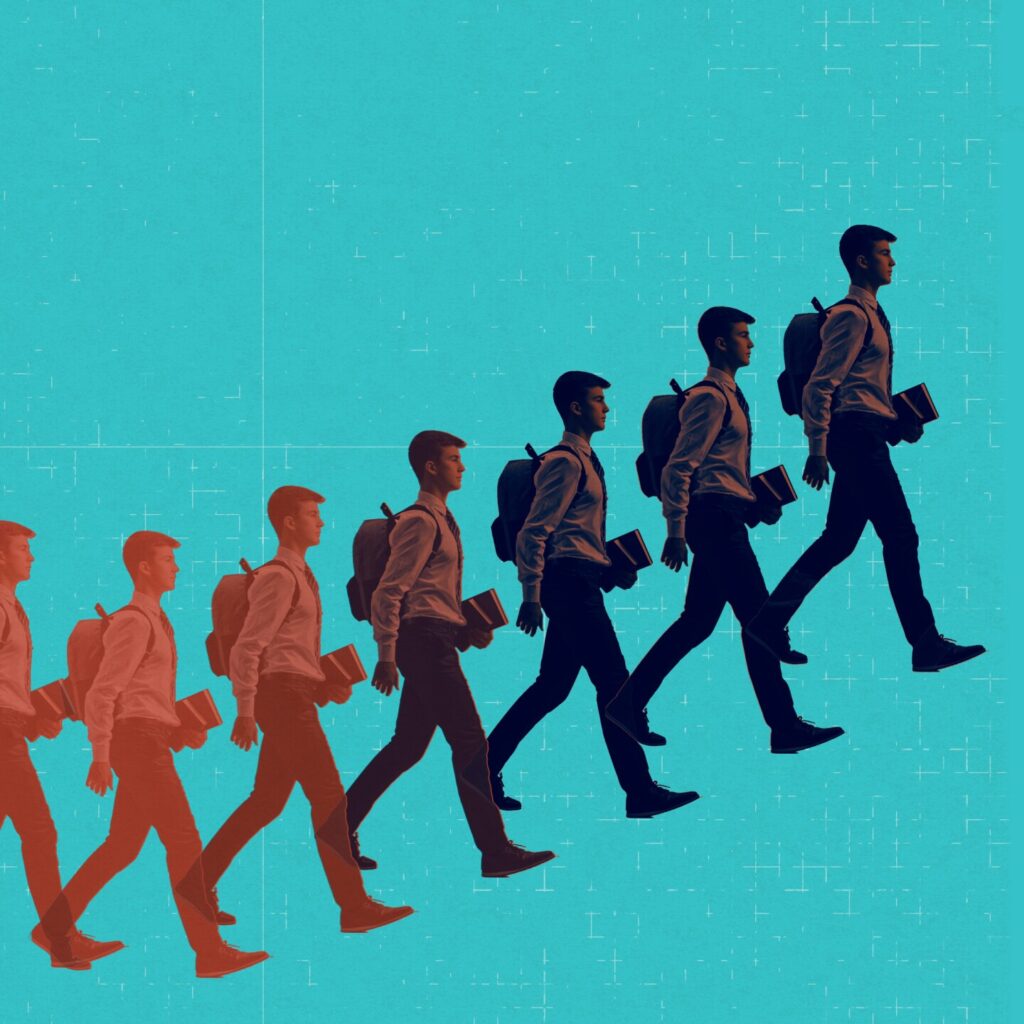Obstacles & Opportunity
Registering for the wrong class permanently changed the educational outlook of Joseph Nelson, PhD. Today, he works to ensure that all young men have equal access to education’s transformative effects.
Since 2011, college enrollment has steadily declined across both sexes, even as the number of high school graduates has continued to increase. Even so, there are notable differences between demographics in this decline. While female student enrollment has dropped by approximately two hundred thousand, male students have one million fewer students enrolled in four-year institutions.
As the first member of his family to achieve a four-year degree, Nelson is inherently familiar with the struggle of pursuing higher education, particularly as a low-income student. When he accidentally joined a PhD-level course, however, he found himself inspired to go beyond, leading to his current position as an Associate Professor of Educational Studies and Chair of the Black Studies Program at Swarthmore College. Still, this path was fraught with challenges.
“I remember telling my grandfather that I was going to move to New York City and pursue a PhD. In his mind, I had had enough school; it was time to go to work,” he recounted.
These worries were supplemented by financial concerns, which Nelson highlighted as an element he couldn’t fully consider at the time.
“I wasn’t registering how much debt was accumulating,” Nelson shared. “I was still very much in survival mode, which created a delusion that more school shouldn’t necessarily be a bad thing.”
Nelson’s experience reflects that of many students, where a chance encounter results in a lifelong passion despite its difficulties. Yet, the modern student faces additional financial, emotional, and social challenges in pursuing higher education—and many have decided it simply isn’t worthwhile.
Societal Standards & Psychological Obstacles
Nelson’s work, which promotes K-12 educational equity for Black males in areas of concentrated poverty, highlights the societal standards addressed by investigations of academic success. These include a variety of environmental and personal factors key to the future of male educational attainment.
Notably, Nelson is a Co-Chair of the Task Force on Boys in School, which examines the psychological identities of boys and explores methods for achieving greater academic success on a national scale.
A fellow member of the Task Force and Counseling Psychologist of healthy masculinities, Saed Hill, PhD, is also a part of the Conduct Awareness Program of Yale’s Sexual Harassment & Assault Response & Education (S.H.A.R.E.) resource, which seeks to promote understanding of proper sexual behavior and opportunities for self-reflection.
“I have been tracking a lot of issues that boys and men seem to have in establishing and maintaining real, in-depth relationships with each other and with other people,” Hill said. “We also know that boys tend to have much higher rates of ADHD and other behavioral conditions, so there may be misunderstandings on how to address the behavioral dynamics of boys in classroom settings.”
Though neurodivergent disorders can present with varied symptoms, male students are far more likely to “externalize” in moments of distress, resulting in a greater likelihood of punishment due to disruptive behavior. This often contributes to an association of learning with punishment, discouraging active interest.
Josangel Almonte, a male student in Yale’s class of 2029, spoke of the divide between male and female educational attainment at Centereach High School in Suffolk County, Long Island. “I remember being in advanced classes, and most of the students were girls. Most of my peers pursuing higher education were girls. Instead, many of the men in my hometown chose to follow in the footsteps of their fathers in [small family-owned] businesses.”
This pattern of educational attainment is supplemented by traditional masculinity, which may reduce a student’s comfort in pursuing additional resources. Hill has coined the phrase “restrictive masculinity” to describe the implications of this male cultural phenomenon.
“A lot of men and boys are being asked to always be the breadwinners or always be tough, stoic, strong, and in control. What we know is that there’s nothing wrong with being some of those things sometimes, but we can’t be all of those things all of the time. That’s the restrictive part,” Hill explained.
Such issues may be accentuated by the rise of social media, which can create environments of “restrictive masculinity” while isolating an individual from their in-person peers. This trend is most visible in the rise of influencers who typically reflect traditional views of “toxic” masculinity, such as Andrew Tate. Though he is most widely known for his remarks against women and strong conservative opinions, as a social media figure, he, too, offers advice to the young men who follow him in finding financial success.
Among his many recordings, Tate highlights the importance of money in his daily lifestyle, a belief offset by his absolute faith in success if young adults “work hard.” In turn, Tate frequently denounces the value of modern education, referring to it as a form of “slavery.”
Although he only represents a continuing trend of publicly showcasing exorbitant wealth, he and many other masculinity-focused influencers make financial resources an overwhelming priority for many of their male viewers.
The focus of many social media sectors on financial success highlights a discussion of viability, which, for some students, is central to their choice to attend college. According to Hill, “college is so much more expensive than it used to be. If we’re always going to talk about money, then of course, I think you’re going to lose out on the idea that college is a worthwhile gamble.”

A Question of Worth
Male and female students both face financial uncertainty, so it is unlikely that this alone has created significant enrollment disparities. However, personal and environmental circumstances, trade professions, and disparities in educational preparedness might widen the gender gap.
According to Josangel Almonte ’29, attending college was an essential choice for him to access increased earning potential, though he understands why others may select a different pathway.
“For me, an education is almost priceless, but if you’re willing to pursue a trade, and the pay of that trade meets your needs, college may not be the best financial plan for you.”
Institutions such as the American Institute for Boys and Men have sought to investigate and address these concerns through policy development, highlighting an opportunity for cohesive improvement. Their Head of Research, Ben Smith, PhD., recognizes the role of financial resources in higher education.
“Men are less likely to take on student debt,” Smith explained, “They may see it as a little riskier in the sense that it connects less clearly to a career for them.”
This may encourage men to immediately enter the workforce, a decision supplemented by their geographic location, preparedness for higher education, and the availability of high-paying labor-intensive positions.
According to Smith, “The most common response from boys about what they want to do later in life is ‘I don’t know,’ while girls have far more concrete ideas.”
Another expert in male education at the University of Southern California, Adrian Huerta, PhD., offered a perspective regarding the nature of the male mindset in relation to higher education and the immediate validation of a high-paying career.
“If you can easily start making $25-30 an hour, you question the value of attending college,” Huerta stated.
These positions, such as construction, HVAC, or utility professions, provide opportunities that
aren’t typically available to women. The rise of Career and Technical Education (C.T.E.) programs, which allow high school students to obtain professional certifications, adds to the appeal of these fields, according to Smith.
“CTE is a legitimate pathway that has its benefits in terms of graduation rates, employment, and wages,” he said.
Even so, he emphasized that these programs are not necessarily a deterrent from a student’s choice to pursue higher education. Instead, Smith offered that the most central component should be finding a “good fit” for an individual’s needs.
As an Associate Professor in the Pullias Center for Higher Education and the Department of Population & Public Health Sciences at the University of Southern California, Adrian Huerta has investigated the educational pipeline for gang-involved populations, men of color, and student parents. He offered that this “fit,” however, is often involuntary.
“Some of the challenges, especially in K-12, are that students, often in their senior year, are ready to get serious about school, but unfortunately, it’s too late at that point to prepare for a competitive four-year university.”
This late desire to pursue higher education is one Huerta has observed in gang-impacted individuals as well. To promote their return to higher education, he established the Phoenix Scholars program in partnership with a local community college.
Just as Huerta characterizes gang involvement as a largely “structural symptom,” many male students desire further education and are unable to access it with cultural, financial, and personal circumstances in mind.
The Future of Education and Inclusivity
Undoubtedly, reduced male enrollment has and will continue to impact educational environments and the future of the workforce, prompting questions of the appropriate response and methods to ensure perpetually extended opportunity.
Hill notes that, in a quickly changing political, educational, and social world, the exact path may be unclear, but select central ideas remain.
“We have to continue to recruit across geography, socioeconomic strata, you know, really fund bridge programs that prepare first-generation and male students from underserved communities,” he stated.
Nelson touched on similar principles, highlighting the duty of colleges and universities to “double down even more on ensuring that they are inclusive spaces and are responsive to the increasing diversity in our society.”
However, when attempting to navigate present-day changes to educational and institutional structures, implementing these amendments can be difficult. For a time, according to Huerta, admissions officials in many schools considered an informal version of affirmative action to boost the volume of male applicants, but the multifaceted nature of reduced enrollment introduced complications.
“I think that’s where the tension is—how do you support young men in an equitable way to reach higher education without causing a negative impact on young women?” he questioned. “How do we make sure that it’s equal for everyone, knowing that many things are unequal?”
In spite of the challenges, Nelson continues to champion the importance of education for helping people achieve their ideals. “I believe in the promise of both K-12 education in the US and American higher education. I think it has extraordinary promise and potential to give all American citizens the knowledge and skills to lead the lives that they want to live,” he stated. Even so, “the majority of American citizens die in the social class that they were born into. It’s only a small percentage of American citizens who are able to move from one social class to the next.”
For many, education is a lifeline. Directing societal attention to toxic social media trends, rising costs of college, and the resulting desirability of trade jobs is necessary to ensure this lifeline remains accessible to all.

